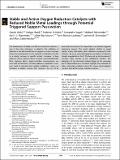| dc.contributor.author | Göhl, Daniel | |
| dc.contributor.author | Rueß, Holger | |
| dc.contributor.author | Schlicht, Stefanie | |
| dc.contributor.author | Vogel, Alexandra | |
| dc.contributor.author | Rohwerder, Michael | |
| dc.contributor.author | Mayrhofer, Karl JJ | |
| dc.contributor.author | Bachmann, Julien | |
| dc.contributor.author | Román-Leshkov, Yuriy | |
| dc.contributor.author | Schneider, Jochen M | |
| dc.contributor.author | Ledendecker, Marc | |
| dc.date.accessioned | 2021-10-27T19:58:01Z | |
| dc.date.available | 2021-10-27T19:58:01Z | |
| dc.date.issued | 2020 | |
| dc.identifier.uri | https://hdl.handle.net/1721.1/134087 | |
| dc.description.abstract | © 2020 The Authors. Published by Wiley-VCH Verlag GmbH & Co. KGaA. The development of stable, cost-efficient and active materials is one of the main challenges in catalysis. The utilization of platinum in the electroreduction of oxygen is a salient example where the development of new material combinations has led to a drastic increase in specific activity compared to bare platinum. These material classes comprise nanostructured thin films, platinum alloys, shape-controlled nanostructures and core–shell architectures. Excessive platinum substitution, however, leads to structural and catalytic instabilities. Herein, we introduce a catalyst concept that comprises the use of an atomically thin platinum film deposited on a potential-triggered passivating support. The model catalyst exhibits an equal specific activity with higher atom utilization compared to bulk platinum. By using potential-triggered passivation of titanium carbide, irregularities in the Pt film heal out via the formation of insoluble oxide species at the solid/liquid interface. The adaptation of the described catalyst design to the nanoscale and to high-surface-area structures highlight the potential for stable, passivating catalyst systems for various electrocatalytic reactions such as the oxygen reduction reaction. | |
| dc.language.iso | en | |
| dc.publisher | Wiley | |
| dc.relation.isversionof | 10.1002/CELC.202000278 | |
| dc.rights | Creative Commons Attribution 4.0 International license | |
| dc.rights.uri | https://creativecommons.org/licenses/by/4.0/ | |
| dc.source | Wiley | |
| dc.title | Stable and Active Oxygen Reduction Catalysts with Reduced Noble Metal Loadings through Potential Triggered Support Passivation | |
| dc.type | Article | |
| dc.contributor.department | Massachusetts Institute of Technology. Department of Chemical Engineering | |
| dc.relation.journal | ChemElectroChem | |
| dc.eprint.version | Final published version | |
| dc.type.uri | http://purl.org/eprint/type/JournalArticle | |
| eprint.status | http://purl.org/eprint/status/PeerReviewed | |
| dc.date.updated | 2021-06-22T17:00:16Z | |
| dspace.orderedauthors | Göhl, D; Rueß, H; Schlicht, S; Vogel, A; Rohwerder, M; Mayrhofer, KJJ; Bachmann, J; Román-Leshkov, Y; Schneider, JM; Ledendecker, M | |
| dspace.date.submission | 2021-06-22T17:00:17Z | |
| mit.journal.volume | 7 | |
| mit.journal.issue | 11 | |
| mit.license | PUBLISHER_CC | |
| mit.metadata.status | Authority Work and Publication Information Needed | |
